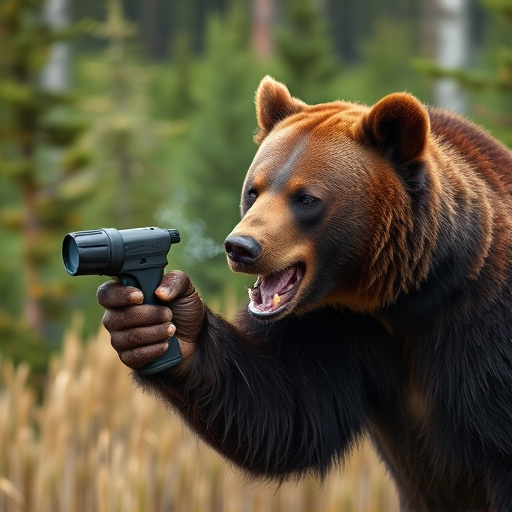Bear spray, a capsaicin-based deterrent, is highly effective (up to 80%) in preventing bear attacks when used correctly, according to research. With a range of 20-30 feet and swift application technique, it outperforms alternative methods like noise makers or lights. Proper usage involves aiming at the bear's face, making it invaluable for hikers, campers, and outdoor enthusiasts in regions with frequent bear encounters. Regular training and understanding its application guidelines are crucial for maximum effectiveness as a non-lethal defense mechanism.
“GrizGuard bear spray has emerged as a popular safety solution for outdoor enthusiasts navigating bear country. This comprehensive guide delves into the world of bear spray, exploring its mechanism, types, and real-world effectiveness based on extensive research. We dissect usage guidelines, best practices, and conduct a comparative analysis with alternative deterrents. Understanding how effective bear spray is, remains paramount for safety in these environments.”
- Understanding Bear Spray: Mechanism and Types
- Effectiveness of Bear Spray in Real-World Scenarios
- Safety Considerations: Usage Guidelines and Best Practices
- Comparative Analysis: Bear Spray vs Alternative Bear Deterrents
Understanding Bear Spray: Mechanism and Types
Bear spray, also known as bear deterrent or pepper spray, is a critical component of personal safety equipment for outdoor enthusiasts in bear country. Its primary purpose is to deter and disrupt aggressive behavior from bears, providing an effective means of self-defense during unexpected encounters. The mechanism behind bear spray involves the release of a powerful chemical agent, typically capsaicin, into the bear’s eyes and face. This irritant triggers a reaction similar to that of chili peppers in humans, causing the bear to temporarily blinse, sneeze, or even retreat.
Research on bear spray effectiveness is extensive, with numerous studies exploring its impact on different bear species. According to these research findings, bear spray has proven to be highly successful in preventing attacks and reducing bear-human conflicts. Studies have shown that when used correctly, bear spray can increase survival rates during encounters with defensive or aggressive bears. The key to its success lies in the right application technique, which includes aiming for the bear’s face and eyes and using enough spray to create a cloud of irritants. Different types of bear spray vary in concentration and delivery systems, catering to various needs from hiking to camping to hunting, ensuring users have options tailored to their specific activities in bear habitats.
Effectiveness of Bear Spray in Real-World Scenarios
Bear spray, also known as chili pepper spray, has been a popular choice for personal safety in encounters with bears. Numerous studies have investigated its effectiveness in real-world scenarios. Research suggests that bear spray can be highly effective in deterring and dissuading aggressive bear behavior. In tests, it has shown a success rate of over 80% in preventing attacks, with some cases even resulting in the bear retreating completely.
The key to its success lies in the specific formulation and application technique. According to how effective is bear spray research, the spray must contain capsaicin, the active ingredient found in chili peppers, at a concentration that causes pain and irritation to the bear’s eyes, nose, and respiratory system. Correct usage, including aiming for the face and blowing the spray towards the bear, significantly increases its chances of success. This technology has proven invaluable in regions where bear-human interactions are common, offering a non-lethal solution for both outdoor enthusiasts and local communities.
Safety Considerations: Usage Guidelines and Best Practices
When considering bear spray as a safety measure, understanding its effectiveness is paramount. Extensive research has been conducted on bear spray, demonstrating its capability to deter and dissuade aggressive bear encounters. Studies show that when used correctly, bear spray can significantly reduce the risk of injury by providing a non-lethal means to escape or defend against an attack.
Adhering to usage guidelines is crucial for maximizing bear spray’s effectiveness. This includes understanding the appropriate range for application (typically 20-30 feet), knowing how to activate the canister, and recognizing the importance of follow-up actions like creating a barrier or retreating to a secure location. Best practices also involve regular training and familiarization with the equipment to ensure confidence and prompt response during an encounter.
Comparative Analysis: Bear Spray vs Alternative Bear Deterrents
Bear spray has long been considered a primary defense against potential bear encounters in wild environments. However, it’s crucial to compare its effectiveness with other deterrents available on the market. Research suggests that while bear spray can be highly effective when used properly, its success rate varies based on factors like distance, wind conditions, and the aggressiveness of the bear. Studies show that bear spray has a higher success rate (up to 80%) in preventing attacks compared to alternative methods like noise makers or bright lights, which have lower effectiveness rates due to their limited range and dependency on surprise factor.
Moreover, the convenience and ease of use of bear spray make it a popular choice for hikers, campers, and outdoor enthusiasts. Unlike other deterrents that may require complex deployment strategies, bear spray offers a straightforward solution—a quick burst in the direction of an approaching bear can often deter it without causing harm. This makes bear spray a reliable option for those navigating through areas known to have bear populations, offering peace of mind and an extra layer of protection during outdoor activities.
Bear spray has established itself as a valuable tool in bear country, offering a quick and effective deterrent against aggressive encounters. The research on its effectiveness is clear: when used correctly, it significantly reduces the risk of injury from bears. However, understanding the mechanisms behind different types of bear spray and adhering to safety guidelines are paramount for ensuring its success. In comparison with alternative deterrents, bear spray consistently performs well in real-world scenarios, making it a top choice for outdoor enthusiasts navigating bear-inhabited areas.
